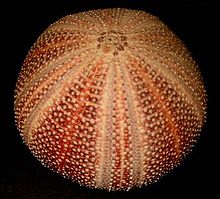Edible sea urchin
| Edible sea urchin | ||||||||||||
|---|---|---|---|---|---|---|---|---|---|---|---|---|

Edible sea urchin ( Echinus esculentus ) |
||||||||||||
| Systematics | ||||||||||||
|
||||||||||||
| Scientific name | ||||||||||||
| Echinus esculentus | ||||||||||||
| Linnaeus , 1758 |
The edible sea urchin ( Echinus esculentus ) is a sea urchin widespread on the Atlantic coasts of Western Europe .
features
Echinus esculentus has an approximately spherical body, slightly flattened at both poles, with a diameter of up to 16 cm and a reddish to pink color. The brittle, stiff shell made of lime is divided into five surfaces with suction cups and five areas running between them, each with two rows of plates, so that the shell has a total of 20 rows of lime plates. The entire shell is covered with spikes, each with a hinge on a nodule on the shell. On every third to third calcareous plate there is a longer primary spine and in between numerous shorter secondary spines formed later. The ends of the spines are blunt and mostly white to light pink in color. The ambulacral surfaces of the bowl have a symmetrical pattern of holes on their plates through which the suction feet emerge. Pedicellaria with small forceps, each with two lateral teeth and one end tooth, sit on the buccal plates around the mouth on the underside .
Reproduction

The edible sea urchin is separate from the sexes. The females release their egg cells, the males their sperm, especially in spring, into the open sea, where fertilization takes place. A large female releases up to 20 million eggs. The free-swimming larvae form part of the zooplankton and develop over several stages - including blastula , gastrula and a four-armed Echinopluteus - until they sink to the bottom after several months (in laboratory tests after about 45 to 60 days) and metamorphose into sea urchins . The metamorphosis usually takes place in autumn or winter, with most of the young sea urchins found in deeper areas below the kelp zone .
Occurrence and habitat
Echinus esculentus is widespread in the North Sea and can be found on the coasts of Portugal , Spain , France , Belgium , the Netherlands , Denmark , Norway , Sweden , Great Britain and Ireland . It lives on hard, rocky ground down to a depth of 1200 m.
nutrition
Echinus esculentus grates both algae and sessile animals from the substrate with the help of its Aristotle lantern . Among other things, barnacles , hydroid polyps , tunicates , bog animals and algae of the genus Laminaria serve as food , but also mud and detritus.
Commensals and parasites
The multi- bristle Adyte assimilis and the copepod Pseudoanthessius liber are often found as commensals between the spines of the sea urchin. The copepod Asterocheres echinola often lives in the intestines of the sea urchin as an endoparasite .
Use by humans
The species name given by Carl von Linné Echinus esculentus , "Edible sea urchin", suggests that the sea urchin has long served humans as food. The gonads of both females and males are particularly eaten . The sea urchins are collected on the European coasts, but research is also being carried out into aquaculture possibilities, for example on the west coast of Scotland .
literature
- Patrick L. Colin: Marine Invertebrates and Plants of the Living Reef. TFH Publications, Neptune (New Jersey) 1978. pp. 419-422. ISBN 0-86622-875-6 .
Web links
Individual evidence
- ↑ a b M. J. de Kluijver, SS Ingalsuo: Macrobenthos of the North Sea - Echinodermata, Common Sea Urchin (Echinus esculentus). Marine Species Identification Portal. Retrieved August 7, 2018.
- ↑ John H. Barrett, Charles Maurice Yonge: Collins Pocket Guide to the Seashore. Collins, London 1958. p. 181.
- ↑ a b MarLIN: Edible sea urchin - Echinus esculentus. Retrieved August 7, 2018.
- ^ EW MacBride: Textbook of Embryology. Vol. I, Invertebrata. MacMillan & Co., London 1914.
- ^ EW MacBride (1903): The development of Echinus esculentus together with some points on the development of E. miliaris and E. acutus. Philosophical Transactions of the Royal Society of London, Series B, 195, 285-327.
- ↑ CA Comely, AD Ansell (1988): Invertebrate associates of the sea urchin Echinus esculentus L. from the Scottish west coast. Ophelia 28, pp. 111-137.
- ^ Encyclopedia of Marine Life of Britain and Ireland
- ^ JM Lawrence (1975): On the relationship between plants and sea-urchins. Oceanography and Marine Biology, Annual Review 13, pp. 213-286.
- ↑ John M. Lawrence (2001): Edible Sea Urchins: Biology and Ecology. Developments in Aquaculture and Fisheries Science 32, pp. 1-4. doi = 10.1016 / S0167-9309 (01) 80002-8
- ↑ MS Kelly, PV Owen, P. Pantazis (2001): The commercial potential of the common sea urchin Echinus esculentus from the west coast of Scotland. Hydrobiologia 465 (1-3), pp. 85-94. doi = 10.1023 / A: 1014553010711
